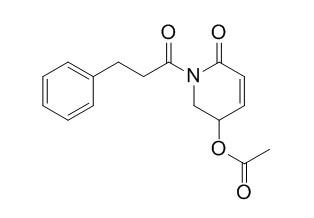Pipermethystine
Pipermethystine induces mitochondrial toxicity in human hepatoma cells, it is capable of causing cell death, probably in part by disrupting mitochondrial function, thus, it may contribute to rare but severe hepatotoxic reactions to kava.
Inquire / Order:
manager@chemfaces.com
Technical Inquiries:
service@chemfaces.com
Tel:
+86-27-84237783
Fax:
+86-27-84254680
Address:
1 Building, No. 83, CheCheng Rd., Wuhan Economic and Technological Development Zone, Wuhan, Hubei 430056, PRC
Providing storage is as stated on the product vial and the vial is kept tightly sealed, the product can be stored for up to
24 months(2-8C).
Wherever possible, you should prepare and use solutions on the same day. However, if you need to make up stock solutions in advance, we recommend that you store the solution as aliquots in tightly sealed vials at -20C. Generally, these will be useable for up to two weeks. Before use, and prior to opening the vial we recommend that you allow your product to equilibrate to room temperature for at least 1 hour.
Need more advice on solubility, usage and handling? Please email to: service@chemfaces.com
The packaging of the product may have turned upside down during transportation, resulting in the natural compounds adhering to the neck or cap of the vial. take the vial out of its packaging and gently shake to let the compounds fall to the bottom of the vial. for liquid products, centrifuge at 200-500 RPM to gather the liquid at the bottom of the vial. try to avoid loss or contamination during handling.
Antioxidants (Basel).2022, 11(12):2327.
Molecules. 2013, 18(7):7376-88
Industrial Crops and Products2023, 199:116746.
Naunyn Schmiedebergs Arch Pharmacol.2017, 390(10):1073-1083
Biochemical Systematics and Ecology2018, 81
Chemistry of Plant Materials.2019, 215-222
Comput Biol Chem.2019, 83:107096
Exp Parasitol.2017, 183:160-166
Front Pharmacol.2022, 13:870553.
Thorac Cancer.2023, 14(21):2007-2017.
Related and Featured Products
Toxicological Sciences,2004,79(1):106–111.
In Vitro Toxicity of Kava Alkaloid, Pipermethystine, in HepG2 Cells Compared to Kavalactones.[Reference:
WebLink]
Kava herbal supplements have been recently associated with acute hepatotoxicity, leading to the ban of kava products in approximately a dozen countries around the world. It is suspected that some alkaloids from aerial kava may have contributed to the problem. Traditionally, Pacific Islanders use primarily the underground parts of the shrub to prepare the kava beverage. However, some kava herbal supplements may contain ingredients from aerial stem peelings.
METHODS AND RESULTS:
The aim of this study was to test the in vitro effects of a major kava alkaloid, Pipermethystine (PM), found mostly in leaves and stem peelings, and kavalactones such as 7,8-dihydromethysticin (DHM) and desmethoxyyangonin (DMY), which are abundant in the roots. Exposure of human hepatoma cells, HepG2, to 100 μM PM caused 90% loss in cell viability within 24 h, while 50 μM caused 65% cell death. Similar concentrations of kavalactones did not affect cell viability for up to 8 days of treatment.
CONCLUSIONS:
Mechanistic studies indicate that, in contrast to kavalactones, PM significantly decreased cellular ATP levels, mitochondrial membrane potential, and induced apoptosis as measured by the release of caspase-3 after 24 h of treatment. These observations suggest that PM, rather than kavalactones, is capable of causing cell death, probably in part by disrupting mitochondrial function. Thus, PM may contribute to rare but severe hepatotoxic reactions to kava.
Toxicological ences : an official journal of the Society of Toxicology, 2007, 97(1):214.
Effects of Kava Alkaloid, Pipermethystine, and Kavalactones on Oxidative Stress and Cytochrome P450 in F-344 Rats.[Reference:
WebLink]
Kava-containing products remain popular in the United States and continue to be sold in health food stores and ethnic markets regardless of the fact that it was banned in Western countries such as Germany, France, Switzerland, Australia, and Canada, following reports of alleged hepatotoxicity. It is therefore critical to establish efficacy and verify adverse effects and/or herb-drug interactions for kava-kava (Piper methysticum). We have previously demonstrated that kava alkaloid, Pipermethystine (PM), abundant in leaves and stem peelings, induces mitochondrial toxicity in human hepatoma cells, HepG2, as compared with the bioactive components, kavalactones (KL), abundant in the rhizome.
METHODS AND RESULTS:
The current study compared short-term toxic effects of PM in Fischer-344 (F-344) rats to acetone-water extracts of kava rhizome (KRE).
CONCLUSIONS:
Treatment of F-344 rats with PM (10 mg/kg) and KRE (100 mg/kg) for 2 weeks failed to elicit any significant changes in liver function tests or cause severe hepatic toxicity as measured by lipid peroxidation and apoptosis markers such as malondialdehyde, Bax, and Bcl-2. However, PM-treated rats demonstrated a significant increase in hepatic glutathione, cytosolic superoxide dismutase (Cu/ZnSOD), tumor necrosis factor α mRNA expression, and cytochrome P450 (CYP) 2E1 and 1A2, suggesting adaptation to oxidative stress and possible drug-drug interactions.
Phytochemistry, 2003, 63(2):193-198.
Piperidine alkaloids from Piper methysticum.[Reference:
WebLink]
METHODS AND RESULTS:
Pipermethystine (1), 3alpha,4alpha-epoxy-5alpha-Pipermethystine (2) and awaine (3) were isolated from the aerial parts of kava (Piper methysticum G. Forster, Piperaceae) and identified by HRMS and NMR spectroscopic analysis. 1 was concentrated in the stem peelings and leaves. 2 and 3 are new alkaloids with 2 found only in cv. Isa among the 11 cultivars examined, and 3 occurred primarily in young leaves of all cultivars.
CONCLUSIONS:
The stem peelings have been used in recent years as a source of kavalactones in kava dietary supplement industry. Quantitative aspects of these piperidine alkaloids in P. methysticum and their potential activities on human physiology are discussed.



